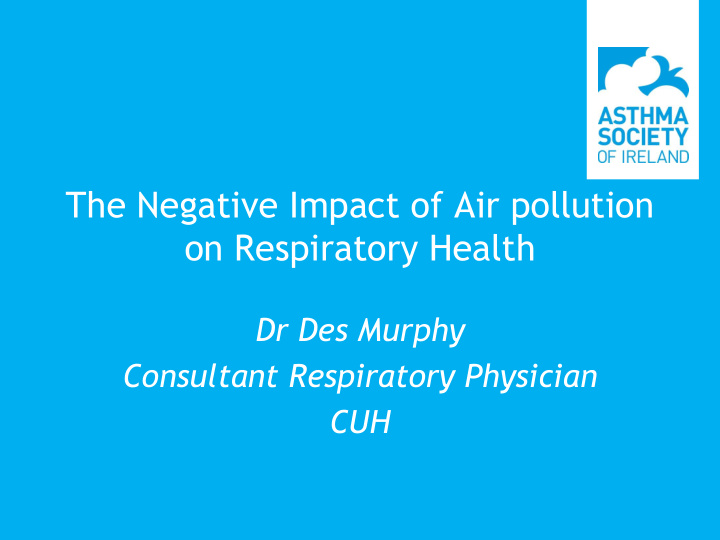



The Negative Impact of Air pollution on Respiratory Health Dr Des Murphy Consultant Respiratory Physician CUH
The Lung • In direct contact with the external environment every time we breath. • Uniquely susceptible to damage from external airborne ‘assault’. • Huge diversity of potential insults to the airway.
COPD : • A disease state characterised by incompletely reversible, progressive airflow obstruction that is associated with inflammation in the lungs caused by prolonged exposure to tobacco smoke and other noxious particles and gases. • Chronic Bronchitis and Emphysema.
Genetic factors COPD
Pathogenesis of COPD
• 110,000 people diagnosed with COPD in Ireland and a further 300,000 potentially undiagnosed. - The Global Initiative for Chronic Obstructive Pulmonary Disease. -Brennan N, et al. INHALE report 2007. • In Ireland COPD accounts for 22% of total respiratory mortality. • 13,000 admissions with the primary diagnosis of COPD in Ireland each year. - Brennan N, et al. INHALE report 2007.
Asthma • Asthma is a chronic inflammatory disorder of the airways which is associated with airway hyper-responsiveness leading to recurrent episodes of wheezing, breathlessness and coughing in response to an array of stimuli. • This variable obstruction within the airway is generally reversible either spontaneously or with treatment. Global Initiative for Asthma/
• Asthma is a serious global health problem. -Approximately 300 million asthmatics worldwide. Masoli M, et al. Allergy 2004;59(5):469-78. • The prevalence of asthma is increasing. -In the western world has increased by 50% every decade for the last 40 years. National Center for Health Statistics. Asthma prevalence, health care use and mortality: United States, 2003-2005. http://www.cdc.
• Ireland has the 4th highest prevalence of asthma worldwide -approx 470,000 people affected. • Suboptimal asthma control is associated with significant limitation of activities of daily living and is potentially fatal. -approx 80 deaths per year from asthma in Ireland. The Irish Asthma Society website. http://www.asthmasociety.ie/all-about-asthma/Asthma- Statistics.html.
• Clinical manifestations of asthma are generally well controlled with appropriate therapy. • With improved overall asthma control there is an observed reduction in exacerbations in terms of both frequency and severity. Pawankar R, et al. WAO Journal 2008; S4-S17.
Triggers • Allergens. • Solvents. • Sinusitis/rhinitis. • Sulphur Dioxide/ozone/nitrogen dioxide • PM • TRAP • Occupation. • Smoke. • Pollution. • Weather change. • Exercise, hyperventilation • Infection. • Medications. • GORD. • Stress
General Measures • Reducing exposure to some categories of risk factors improves the control of asthma and reduces medications needs; Reduce exposure to indoor allergens Avoid tobacco smoke Avoid vehicle emission Identify irritants in the workplace Reduce exposure to air pollution.
• 29 th March 2004 Irish Government introduced the worlds 1 st national ban on workplace smoking. • The Public Health (tobacco) act 2002 and the Public Health (tobacco) (amendment) act 2004, prohibit smoking in indoor workplaces, including bars and restaurants to reduce the risks to workers health.
Workplace smoking ban (42 pubs) has: 1. Reduced particulate matter and benzene in pubs. 2. Reduced exhaled CO and salivary cotinine in barmen. 3. Improved health in non smoking bar staff. 4. Improved irritant symptoms in smoking bar staff. 5. Change in attitude of smokers-majority now favour ban.
• Since Dublin smoky coal ban in 1990. • Estimated 359 lives/year saved. (116 respiratory and 243 cardiovascular).
• Real-time system of monitoring air quality/pollution. • Allow patients with respiratory conditions to tailor their activities. • Resultant health and economic benefits- to individual and to society
THANK YOU
Recommend
More recommend